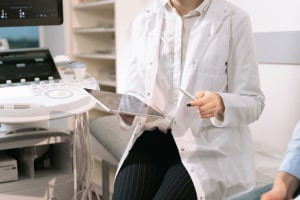Imagine being able to create a robotic prosthetic limb capable of moving and receiving commands through the nervous system much like the real thing, or designing an electric wheelchair for a person who is completely paralyzed that moves just by thinking about the direction you want it to go. Envision someone who has lost the ability to speak being able to communicate their thoughts through a mobile device, or controlling the cursor on your computer with the power of your mind. Picture a new age of online games where a player immerses themselves in a virtual world and controls their online avatar with their mind, or a computer capable of diagnosing and classifying mental disorders by interpreting the electrical impulses of your brain. Some of these things are already possible, and some of them are currently under development, thanks to an exciting field of science known as neurophysiology. This online course in clinical neurophysiology is designed to introduce you to procedures of neurophysiology that will help you understand how to create brain-computer interfaces, how to manufacture electrodes used in electroencephalograms (EEG) and how to diagnose and classify epilepsy using an EEG. It is helpful if you are in training to be an EEG technician.
You start by studying how to pinpoint the exact areas of the brain that emit the electrical signals that are recorded by an electroencephalogram, or an EEG. Understand how brain waves travel through different cortical circuits in the brain. You will then study brain-computer interfaces, the creation of a direct communication pathway between the human brain and a computer interface, whose main purpose is to provide those who have a disability the functionality they lost due to a missing limb or paralysis. Learn how to elicit and record specific event-related potentials in the human brain and how to manipulate these to digitally send a command code to a computer interface. You will explore the functions of a computer program known as EEGLAB to plot and interpret the brain waves obtained from different types of event-related potentials. Become proficient in designing a signal conditioning circuit used in biopotential signal experimentation and how to do a wavelet analysis of the obtained signals. Next, you will move on to study photolithography techniques, a process used in the microfabrication of parts made of thin films, such as the electrodes used in EEG experiments.
Neurophysiology also plays an important role in understanding neurological disorders. This course will explain the applications of neurophysiology in diagnosing, classifying and treating one of these disorders, epilepsy. Study how epilepsy affects those who suffer from it, what the causes of epilepsy are and what happens in the brain during a seizure. Learn how to perform EEG tests aimed at diagnosing epilepsy, and how to determine the type of epilepsy in patients by reading the waveform obtained during the test. Towards the end of this course, you will study a thin-film depositing technique known as physical vapour deposition (PVD). Examine three different PVD methods used for depositing thin films, such as gold or aluminium. Understanding these techniques will help you comprehend how the electrodes used in electroencephalograms are manufactured. This course is very technical but exciting and rewarding. If you don’t have a background in neurophysiology you can take the Diploma in Neurophysiology & Neuro-Instrumentation course first and lay the groundwork for this one. If you already have basic knowledge in this fascinating field and want to expand on that knowledge, this course is for you. Are you ready to study the most up-to-date information and training about neurophysiological applications? Take this Diploma in Neuroscience and Neurophysiological Procedures today!
What You Will Learn In This Free Course
View All Learning Outcomes View Less All Alison courses are free to enrol, study, and complete. To successfully complete this Diploma course and become an Alison Graduate, you need to achieve 80% or higher in each course assessment.
Once you have completed this Diploma course, you have the option to acquire an official Diploma, which is a great way to share your achievement with the world.
Your Alison certificate is:
- Ideal for sharing with potential employers.
- Great for your CV, professional social media profiles, and job applications.
- An indication of your commitment to continuously learn, upskill, and achieve high results.
- An incentive for you to continue empowering yourself through lifelong learning.
Alison offers 2 types of Diploma for completed Diploma courses:
- Digital Diploma: a downloadable Diploma in PDF format immediately available to you when you complete your purchase.
- Physical Diploma: a physical version of your officially branded and security-marked Diploma
All Diplomas are available to purchase through the Alison Shop. For more information on purchasing Alison Diploma, please visit our FAQs. If you decide not to purchase your Alison Diploma, you can still demonstrate your achievement by sharing your Learner Record or Learner Achievement Verification, both of which are accessible from your Account Settings.











 Avg. Hours
Avg. Hours  Contains Video
Contains Video  CPD Accredited
CPD Accredited 
 Total XP:
Total XP: 
 Knowledge & Skills You Will Learn
Knowledge & Skills You Will Learn 






